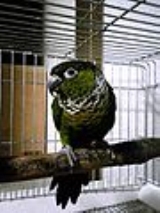
Black-capped Parakeet
Encyclopedia
The Black-capped Parakeet or Rock Parakeet (Pyrrhura rupicola), also known as the Black-capped Conure or Rock Conure in aviculture
, is a parrot
native to the south-western Amazon Basin
and adjacent east Andean slopes in Peru
, Bolivia
and Brazil
. It has a total length of approximately 25 cm, is mostly green with a dark brown-black cap, whitish scaly neck and breast, red wing coverts
(upper, not lower - along leading edge) and a black beak. The breast feathers are dark with light tips, rather than the opposite.
It lives in humid forests, ranging from the Amazonian lowlands up to an altitude of 2000 m. on the East Andean slopes. While its habitat is being disturbed, parts of its range are within protected areas (e.g., in Manú National Park
), and it remains widespread and locally fairly common. Flock size
20-30, smaller in breeding season.
In the past, some speculated that it might be conspecific with the Green-cheeked Conure. This was based on an apparent Black-capped–Green-cheeked hybrid found in Puno
, Peru, though the identification of this individual (or at least its provenance
) must be considered questionable, as beyond the range of the Green-cheeked Conure, which has never been recorded in Peru.
Aviculture
Aviculture is the practice of keeping and breeding birds and the culture that forms around it. Aviculture is generally focused on not only the raising and breeding of birds, but also on preserving avian habitat, and public awareness campaigns....
, is a parrot
Parrot
Parrots, also known as psittacines , are birds of the roughly 372 species in 86 genera that make up the order Psittaciformes, found in most tropical and subtropical regions. The order is subdivided into three families: the Psittacidae , the Cacatuidae and the Strigopidae...
native to the south-western Amazon Basin
Amazon Basin
The Amazon Basin is the part of South America drained by the Amazon River and its tributaries that drains an area of about , or roughly 40 percent of South America. The basin is located in the countries of Bolivia, Brazil, Colombia, Ecuador, Guyana, Peru, and Venezuela...
and adjacent east Andean slopes in Peru
Peru
Peru , officially the Republic of Peru , is a country in western South America. It is bordered on the north by Ecuador and Colombia, on the east by Brazil, on the southeast by Bolivia, on the south by Chile, and on the west by the Pacific Ocean....
, Bolivia
Bolivia
Bolivia officially known as Plurinational State of Bolivia , is a landlocked country in central South America. It is the poorest country in South America...
and Brazil
Brazil
Brazil , officially the Federative Republic of Brazil , is the largest country in South America. It is the world's fifth largest country, both by geographical area and by population with over 192 million people...
. It has a total length of approximately 25 cm, is mostly green with a dark brown-black cap, whitish scaly neck and breast, red wing coverts
Covert (feather)
A covert feather on a bird is one of a set of feathers, called coverts, which as the name implies, cover other feathers. The coverts help to smooth airflow over the wings and tail.- Wing-coverts :...
(upper, not lower - along leading edge) and a black beak. The breast feathers are dark with light tips, rather than the opposite.
It lives in humid forests, ranging from the Amazonian lowlands up to an altitude of 2000 m. on the East Andean slopes. While its habitat is being disturbed, parts of its range are within protected areas (e.g., in Manú National Park
Manú National Park
Manú National Park is a biosphere reserve located in Madre de Dios and Paucartambo, Cusco. Before becoming an area protected by the Peruvian government, the Manú National Park was conserved thanks to its inaccessibility. The park remains fairly inaccessible by road to this day. In 1977, UNESCO...
), and it remains widespread and locally fairly common. Flock size
Group size measures
Many animals, including humans, tend to live in groups, herds, flocks, bands, packs, shoals, or colonies of conspecific individuals. The size of these groups, as expressed by the number of participant individuals, is an important aspect of their social environment...
20-30, smaller in breeding season.
Subspecies
There may be two subspecies. If so, they would be:- P. r. rupicola: Central Peru.
- P. r. sandiae: South-eastern Peru, northern Bolivia and south-western Brazil. Narrower pale edges on breast and neck feathers, absent on hind neck. Often called the Sandia Conure in aviculture.
In the past, some speculated that it might be conspecific with the Green-cheeked Conure. This was based on an apparent Black-capped–Green-cheeked hybrid found in Puno
Puno Region
Puno is a region in southeastern Peru. It is bordered by Bolivia on the east, the Madre de Dios Region on the north, the Cusco and Arequipa regions on the west, the Moquegua Region on the southwest, and the Tacna Region on the south...
, Peru, though the identification of this individual (or at least its provenance
Provenance
Provenance, from the French provenir, "to come from", refers to the chronology of the ownership or location of an historical object. The term was originally mostly used for works of art, but is now used in similar senses in a wide range of fields, including science and computing...
) must be considered questionable, as beyond the range of the Green-cheeked Conure, which has never been recorded in Peru.

